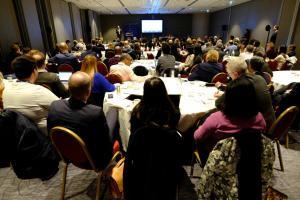This Holiday Season, Have Solace Reflecting on Your Impact over an “Indicator Cocktail”
The Foundation's Lamia Naji Shares a Renewed Lens on Measuring Impact
It’s the end of the year. Hello, December. Hello, reflections.
My biggest takeaway this year is a renewed lens for measuring impact, one that goes beyond a traditional approach of aggregating year-end apples with apples. The cherry-on-top, let’s call it my ah-ha reflection of 2018, was reinforced while recently attending the Global Impact Investing Network (GIIN) Investor Forum in Paris, France.
Here are three nuggets on why impact measurement should take an expansive interpretation come the New Year.
1. Measuring impact is about being united in a macro purpose.
The three-day GIIN Investor Forum brought together over 1,200 stakeholders, coupling traditional international development actors — such as bilaterals (i.e. government aid agencies), multilaterals (eg. UN organizations), Foundations, development finance institutions (DFIs) and non-profits — with investors, notably banks, pension funds, insurance companies, and family offices.
The collective participation of these organizations at the Forum highlights a shared aspiration to contribute to positive social change — individual and/or societal — over time. By deploying grant or investment capital (debt or equity), these organizations pursue a macro-level North Star, speaking to the essence of SDG Goal 17, focused on multi-stakeholder partnerships and cooperation for poverty reduction.
Naturally, organizations participating in the Forum differ in their core mandate, client segments, geographic focus, and, ultimately, in how they define and achieve their own version of impact. And since measuring impact will take different forms across these organizations, the focus shifts from measuring the same indicators across the board, to measuring what makes sense when assessing multi-stakeholder progress towards a broader, common purpose.
2. Success in measuring impact involves intentionality from start to finish.
The Forum convened participants around the theme of “impact investing,” advancing the twin objectives of investing for social outcomes and commercial returns, where the former takes precedence. The explicit reference to “impact” in “impact investing” is meant to foster a clear delineation from traditional investing, including environment, social, and governance (ESG) requirements, responsible investing, and corporate social responsibility (CSR).
While the jury is still out on differences and definitions, what’s important is that the impact investing landscape maintains a clear commitment to measuring the “impact” of its investments. Throughout the Forum, discussions emphasized the importance of starting with a Theory of Change (ToC) to map intended positive outcomes throughout the life-cycle of a project or deal. This was followed by practical considerations around assumptions, risks, negative unintended externalities, and learning questions. In other words, music to the ears of any results measurement professional.
Importantly, the Forum also dedicated time to outlining both progress and sticky challenges around indicators. Measuring impact across a range of stakeholders means data fragmentation. To solve for this, databases such as the IRIS Metrics provide a go-to for common indicators, enabling different stakeholders to collect industry-wide metrics and, in turn, allowing some comparability. Here, the idea is for stakeholders to adopt an organizational measurement framework that blends standardized indicators with their own internally tailored metrics, resulting in a dynamic “cocktail” of indicators.
While still an “evolving practice,” as GIIN’s Mabinty Koroma-Moore puts it, the organization is making strides in measuring performance, most recently demonstrated by its survey findings from its impact measurement and management (IMM) arm. Sustaining the momentum on measuring impact will lead to actionable and data-driven insights for organizations and the sector more broadly.
3. The biggest impact will be anchored in local context and diversity.
Enabling positive change that is sustainable in the long-run is catalyzed through meaningful linkages with local markets. Contextually relevant solutions are driven by a deep understanding of end consumers — their needs, preferences, habits, interests, challenges, and cultural traditions. Implicit in this is the need to strengthen support to a diverse pipeline of entrepreneurs who demonstrate a unique appreciation for a diverse range of end-consumers and user experiences.
Two practical examples surfaced at the Forum demonstrate intentional efforts which move the needle on identifying and enabling diverse talent. Echoing Green, an impact investing accelerator serving over 700 entrepreneurs to-date, explicitly integrates diversity-based considerations into their screening and selection processes. Recognizing the challenge of diversity in venture capital, the Ford Foundation, through its Mission Investments team, strategically invests in building an internal roster of ethnically and gender diverse managers to promote inclusive deals. Progress is being made, and opportunities remain in strengthening engagement with entrepreneurs and investors from emerging markets.
In addition to supporting talent directly, there is a growing effort to expand the evidence-base on disaggregated outcomes. The Global Accelerator Learning Initiative (GALI), for example, is expanding its sample size of women-only accelerators to facilitate an isolated comparison of women-led businesses and gender-specific outcomes.

Attendees take in the impact measurement workshop at the GIIN Investor Forum in Paris, France.
In short, while wrapping up a year by totaling common denominators is intuitive practice for most, I’m closing off 2018 with an appreciation for complexity; where depth through collaboration, intentionality, and diversity are forefront indicators in the years to come. Attending the GIIN Investor Forum underscored the need to appreciate the dynamism and breadth of our big-picture, and sector-wide impact. With so much nuance, this holiday season calls for pairing apples with a refreshing (indicator) cocktail.
About the Author
Lamia Naji is Associate Manager, Strategy and Learning at the Mastercard Foundation


